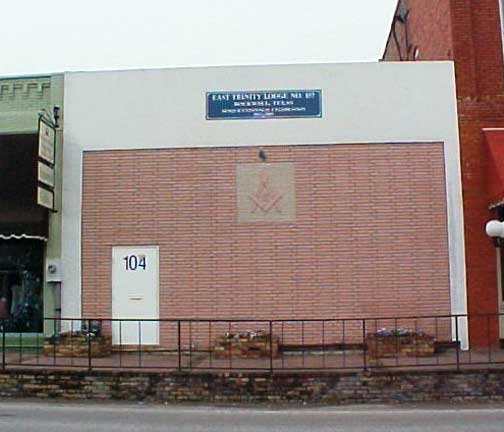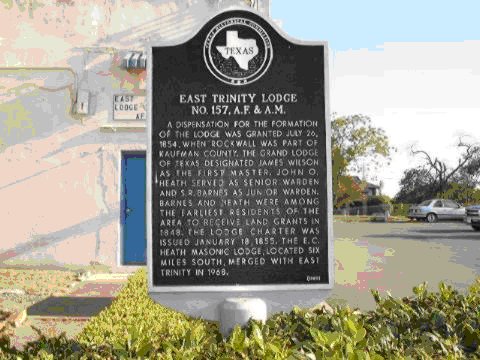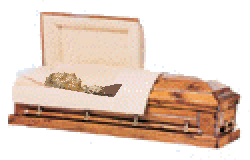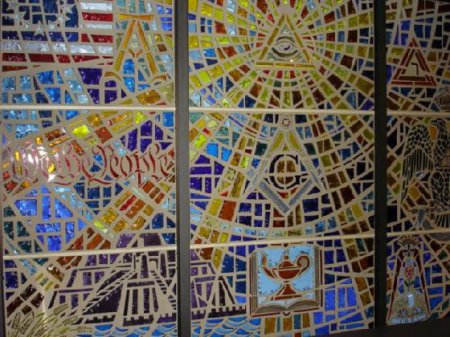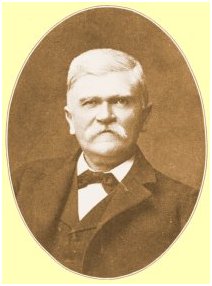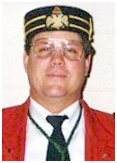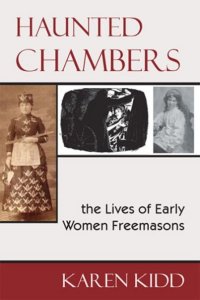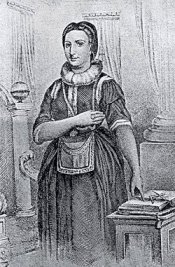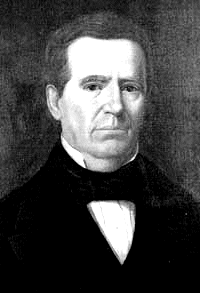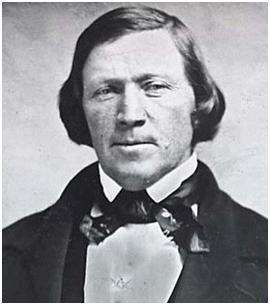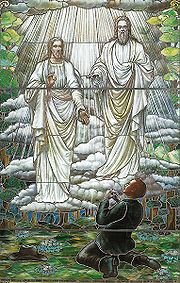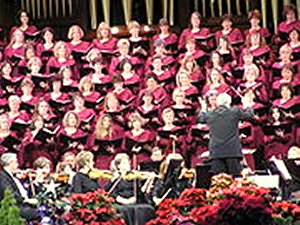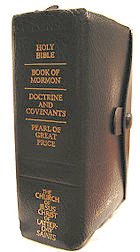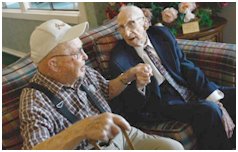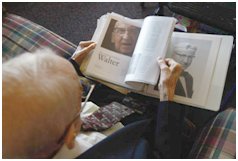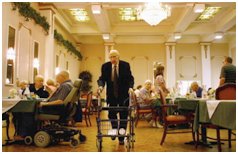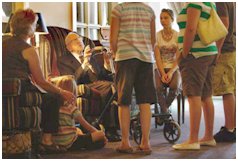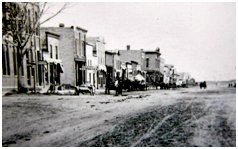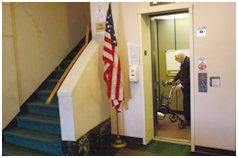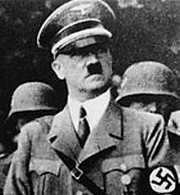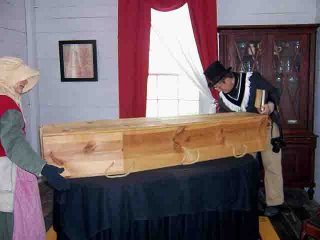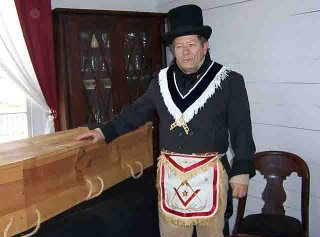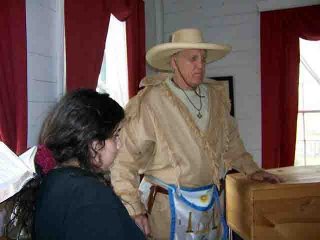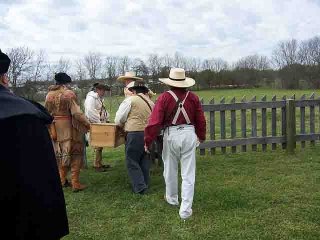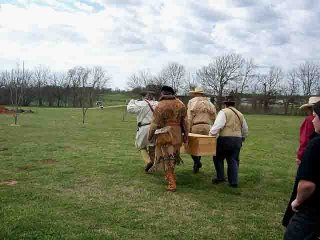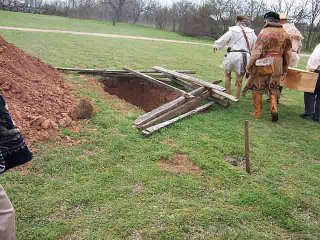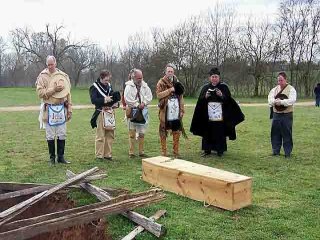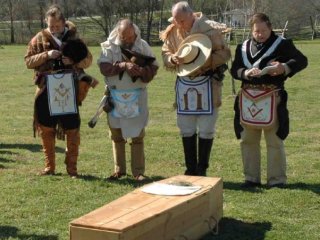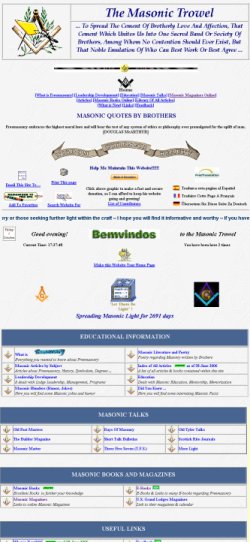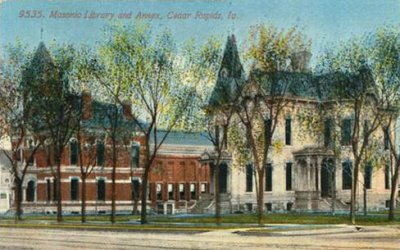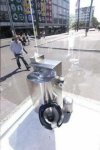
|
December 2009

East Trinity Lodge No. 157, A.F.& A. M.
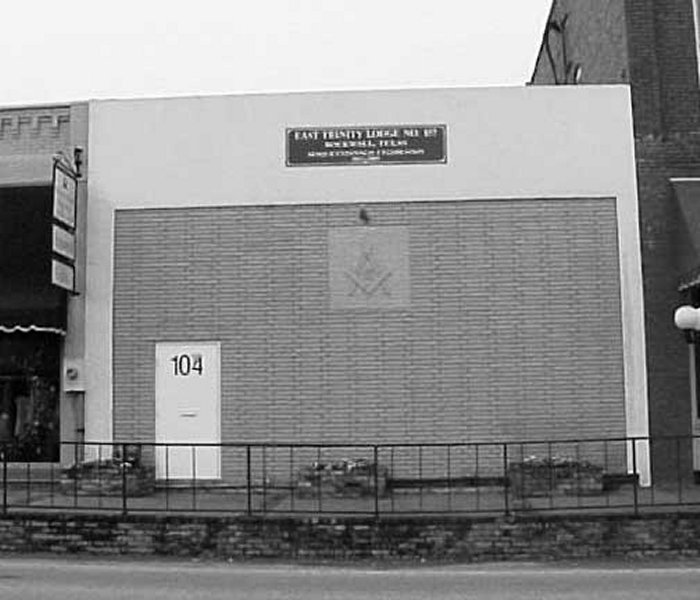 The East Trinity Lodge No. 157, A.F.& A. M. in Commerence, Texas |
|
Page II | |||||||||
|
This Small Town Texas Mason's E-Magazine is not affiliated with any state Grand Lodge or individual Blue Lodge. It was created to enlighten, educate and entertain Masons and non-Masons alike and as title suggests, it does feature a small town Texas Masonic Lodge and a story of Texas Masonic history in each issue The beliefs, ideas and opinions expressed here are strictly those of the authors and not necessarily those of the editor, any individual Blue Lodge or any state Grand Lodge.
A very sincere effort was made to avoid using any copyrighted material, without permission or giving credit to the author, in the creation of this web site. If you discover something that is yours, without giving you due credit, please let me know and due credit will be given or the item will be replaced.
Any material in this site may be used to increase the understanding of Freemasonry.
Story tools: |
East Trinity Lodge No. 157, A.F.& A. M.
Freemasonry's Secrets Unraveled In Collection
This Issue's Visit In Texas Masonic History - H. W. Graber And Jim Freeman
A Short(er) History of Early Women Freemasons
The Anson Jones Historical Marker
Focus On CCTV Proposal For Historic Chapel
The Lost Symbol, Mormonism and Masonry
Freemasonry And The Latter Day Saint Movement
Freemasons Show The Church How To Handle Dan Brown
Oldest Living Man Is Also Oldest Freemason
The Truth Is Fascinating Enough On Its Own
Ft Hood Soldier Is A Former Rainbow Girl!
The Seven Blunders of the Masonic World
Paying Tribute To A Masonic Icon
Freemasonry: What's the Real Scoop?
D.C. Decoder: A Government Vault Worthy Of Dan Brown's Attention
The Frontier Lodge - Masonic Burial Reinactment
The Really Great Masonic Educational Web Sites Series
Computer Dangers For Masons (And Others)
Masons Not As Secretive As 'Lost Symbol' Suggests
| ||||||||
|
Page IV | ||
Brother Abi worked hard to learn his work, it was not always perfect, but he advanced through the chairs with a true effort. At that time, not everyone was deemed qualified to be Master of the Lodge. He memorized and retained the floor work, the opening and closing ceremonies, and a good share of the Masonic lectures. He even devoted himself to learning the Masonic funeral ritual and took the time to impart the same knowledge on his younger Brothers. The beauties of the lessons in the Masonic ritual were important to him and he took the time to make sure that he was able to communicate them properly. When he was not in Lodge he took the time to individually relieve his distressed Brethren. He would visit the ill, run errands for widows, and insure that no Mason in need of some brotherly love was left wanting. This was how Masonry was: a beautiful set of rituals designed to instill morality on the minds of good men and to promote brotherhood and individual charity.
Masonry changed throughout Brother Abi's life, however, and developed into something different. The Brethren began to champion large numbers of members, regardless of the quality, and seemed to adopt the idea that no one was undeserving of Masonry. They allowed anyone through the west gate, often allowing men without a true love of Masonry's tenets into the lodge. The Masons used these greater membership numbers to fund grand buildings and even grander charitable programs. This led to meetings consisting solely of business and Brothers bickering about the finances of the building. Philosophy, brotherhood, and even ritual were no longer important. It was perfectly acceptable to read the ritual and not understand it. Where Masons once were able to engage in the beautifully archaic language of proficiency, new Masons would respond with "Oh I didn't know I needed to remember the grip."
This empty shell of the formerly grand society had to be filled. The unenlightened called for chili feeds, organized charities, and fund raisers. Perhaps if Masonry looked enough like the local Kiwanis or church group it would flourish. Men no longer helped out their fellow Brothers, Masons were too busy exploiting another charity in an attempt to gain new members and too busy putting on another dinner to beg for a few more cents from the public to keep their building open. It was no longer the job of the Masons to improve society, but rather the job of society to keep the Masons alive. Masonry had become an abstract portrait of what it once was.
Brother Abi lost interest. When he became bedridden, no Brothers came to comfort him. The majority of the membership didn't know who he was. This man, who had spent so much time teaching his younger Brothers and working to be the best Mason he could be, a Mason who had carried the flame of the order for so long and had attempted to provide his Brothers with all the rights and benefits of the society has now shuffled off this mortal coil. There will be no Masonic funeral rights, because no one knows them. There will be no Brethren at his side, because they are too busy preparing for a spaghetti dinner to fund their lodge building.
Here lays the body of the late Brother Abi, SO MOTE IT BE! | ||
The Lexington Minuteman
By looking at anti-Masonry in a historical context, objections to Freemasonry have often accompanied
changes in society, such as religious revivals in America to totalitarian regimes in Europe.
In addition to helping understand the history of Freemasonry in America, the anti-Masonic movements and
ideas shed light on the social, political and religious history of the United States. Over time, anti-Masonic
propaganda has taken many forms. Exposés of Masonic ritual have been printed since the early 1700s.
In the 1820s and 1830s, following the kidnapping and presumed murder of a former Mason who threatened
to publish an exposure of Masonic ritual, Americans began producing anti-Masonic newspapers, almanacs,
broadsides and other pieces. During this same period, a political party that promoted anti-Masonic candidates
formed.
Editor Rural Lodge; The museum in Lexington MA is a gift to the country by the Scottish Rite Masons (NMJ). It is open and free to all.. | ||
|
Page V | |||
H. W. Graber And Jim Freeman Texas Pioneer, Businessman, and Freemason
H. Alan "Al" Wilson, 32°
Sand Springs, Oklahoma Civil War and contemporary anecdotes underline the strength of Masonic bonds.
Brother Graber was a member of the Terry Texas Rangers, one of the Civil War's most famous and active units. An incident occurred late in the Civil War that influenced Brother Graber for the rest of his life. General William Tecumseh Sherman had captured Atlanta and was beginning to make his famous March to the Sea. Kilpatrick's Cavalry was leading Sherman's Army. Terry's Rangers were having daily engagements with Kilpatrick's Cavalry. I believe that Brother Graber's own words best describe the incident. "I was at a blacksmith's shop with a comrade by the name of [Jim] Freeman, who was about seven years my senior in age. While waiting to get our horses shod we heard artillery, supported by small arms, open at our works, about a mile across the river. We immediately mounted our horses and dashed over there and just as we got in sight of the roadway through the breastworks we witnessed a lone trooper of Kilpatrick's cavalry coming up the road through the works, having his horse shot just as he reached inside. His horse fell on his leg, from which position he was trying to extricate himself and was about to be shot by an excited militia of young and old men, who had never been under fire before, when Jim put spurs to his horse and with his pistol raised, dashed up to where this man lay under his horse, and drove off the excited militia. I, of course, followed him. He called up a lieutenant, asked his name, company, and regiment; told him to take charge of that prisoner and see that he was well treated, that he would hold him personally responsible for his safety, and immediately wheeled his horse, I following him, and returned to town without giving the lieutenant a chance to ask questions. On our return I asked Jim Freeman his reasons for doing as he did, risking his own life, by being shot by the excited militia, in order to save this Federal. He answered, 'He is a brother Mason.' I asked him if he had ever met him before. He said, 'No, but I saw him give the grand hailing sign of distress, which obligates a Mason to save the life of a brother, at the risk of his own.' Here was a beautiful illustration of the work of Masonry, and I told Jim Freeman the first opportunity I had of joining the Masons, if I lived through the war, I intended to be one, which resolution I carried out, joining the Masons at Rusk, Texas." Brother Jim Freeman followed his Masonic obligations and, in doing so, impressed a non-Mason so much that the man became a Brother Mason. Brother Graber assisted in forming the Rusk Masonic Institute in Rusk, Texas, to school the boys of the area. He served as chairman of the building committee and served on the Board of Trustees. This school produced two Texas State Governors. There is no way that Jim Freeman could imagine that following his oath would affect so many people. Recently, I sat on the committee that reviewed the petition of Bro. Bob Johnson, a fellow Tulsa Police Officer, who had petitioned our Lodge. I asked Bob why he wanted to become a Mason. Bob told me that he had grown up around the Charles Page Home in Sand Springs, Oklahoma. Most of the directors of the home have been Masons. Charles Page was the home's founder, and, although he was not a Mason, Page asked the Grand Master of the State of Oklahoma to appoint the directors of the home. This is a tradition that has carried through today. Bob was not a resident of the home, but his mother worked at the home. Bob's answer to my question made me understand that it is as important today that we be men of principle as it was in Jim Freeman's day. Bob told me that the Charles Page directors had always impressed him as men of character and that he wanted to associate himself with such men.
These two incidents are very different in time and place and yet quite similar. These men followed their Masonic oaths. They were not trying to impress anyone yet impressed everyone they met in their daily lives. We were admonished to act as just and upright men when we first become Master Masons. We will help insure the survival of our beloved Fraternity if we will always remember those words in our dealings with our fellowmen.
| |||
By Tom Whitehead, Home Affairs Editor
Since 1998 those becoming judges or magistrates have been required to say if they are a Mason after the then Home Secretary – Mr Straw – said membership of "secret societies such as freemasonry" could raise suspicions of impartiality and objectivity.
But, now Justice Secretary, Mr Straw has abandoned the requirement after the United Grand Lodge of England threatened legal action following a ruling by the European Court of Human Rights.
In 2007, the court ruled in favour of Italian Masons that making an official declare their membership breached their rights to free association and was discriminatory.
Mr Straw yesterday said a review had shown no evidence of "impropriety or malpractice" as a result of a judge being a Freemason and that it would be "disproportionate" to continue with the practice.
The move sparked a furious backlash in 1998 and attempts to make a similar requirement for police officers was dropped in favour of voluntary declarations.
John Hamill, spokesman for the United Grand Union, said: "We are very happy the right thing has been done at long last." | |||
|
Page VI | |||
|
By Karen Kidd Author of "Haunted Chambers: the Lives of Early Women Freemasons" Reprinted With Permission From Masonic Information
“It is easy to forbid technology to exist in the past because all you have to do is to deny it. Enforcing the ban then becomes a simple matter of remaining deaf, dumb and blind. And most of us have no trouble in doing that when necessary. . . I call it consensus blindness. People agree not to see what they are convinced cannot exist.” Temple made these comments in his paper “Forbidden Technology”, which is about optical technology, long denied by “experts”, that none-the-less existed for millennia. “Consensus blindness” long has been the unwritten/unspoken rule among Malecraft Masons, likewise accepted by many non Masons including women, about the existence of early women Freemasons. However, just as there are lenses in Ancient Egyptian archaeological finds dating to the 4th and 5th dynasties at Abydos, so also have women Masons existed throughout all of the modern Freemasonic period[1].
Claudy, whatever his personal opinions, had no choice but to write about early Women Freemasons in this way. Had he attempted to be more straight-forward, it likely would never have been published. In this way, Claudy and other Masonic writers kept from complete obscurity the lives of these women Freemasons. Their existence is a fact, despite determined effort to ignore, marginalize and deny it. That effort, however, ongoing for centuries, has done its worst. The very vast majority of early women Freemasons are unknown to us. Finding them can take as much effort as it did to obscure them. They include: · Gunnilda the Mason: a female operative mason mentioned by name as living in Norwich in the Calendar of
I've heard my book is a threat to all Freemasonry, Malecraft Masonry in particular. This is no more true than admitting to the existence of their contemporary male brethren is a threat to any part of Freemasonry. All our Brethren who have passed to the Grand Lodge above, be they male or female, are to be remembered and emulated. While none of these women were Co-Masons, they did pave the way for that part of Freemasonry. And, today, women can become Freemasons without eavesdropping, sneaking into lodges or hiding in furniture. For more than a century, Freemasonry has operated in three parts. There is Malecraft Masonry, there is Femalecraft Masonry and there is Co- or Mixed Masonry. And we know this system can work, largely before it does.
And so it will continue with the past duly recalled. I wrote about these women to follow in the tradition of Claudy and other Masonic historians who kept their stories alive. I wrote the truth that this generation, and the next, may find worthy of remembrance.
[1] Temple’s paper was published in the Summer 2001 edition (Issue 17) of Freemasonry Today and is available online here: http://www.freemasonrytoday.com/17/p11.php |
|
Page VII | ||
Dedication At Glenwood Cemetery By Corky 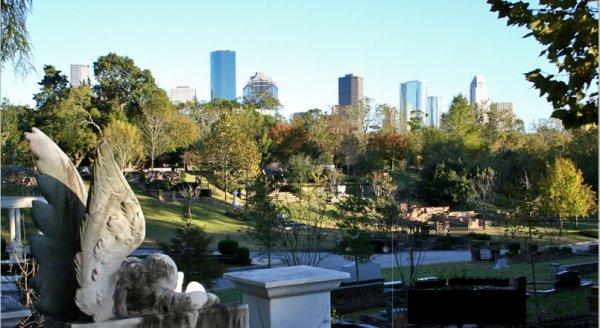 Glenwood Cemetery
Jones was Surgeon of the Second Regiment at the Battle of San Jacinto and he fought in the Battle of San Jacinto when Texas won its independence from Mexico. The charter for Holland Lodge was in his saddlebags during the Battle of San Jacinto. He was Secretary of State of the Republic of Texas. He was the Minister Plenipotentiary from the Republic of Texas to the United States of America. He was a member of the Congress of the Republic of Texas. He was the first Grand Master of the Grand Lodge of Texas. He presided over the official ceremony where Texas ceased to be a Republic and became a State. When the Texas flag was lowered at the ceremony, it was Anson Jones who pronounced, “The Republic of Texas is no more.” He is the only President of any country buried in Houston or Harris County, Texas. Glenwood Cemetery is located in Houston Texas at 2525 Washington Ave. just west of Sawyer St. on the south side of Washington. Some of the notable burials at Glenwood Cemetery are;
· John T. Browne politician, mayor of Houston from 1897 to 1899 and member of Texas House of Representatives | ||
|
Page VIII | ||||||
By Clair Barrus Salt Lake City Mormon History Examiner
All Seeing Eye on Salt Lake Temple (Derek P. Moor)
Since 2003, Dan Brown's book "The Lost Symbol" has been on the mind of many Mormons.
Dan Brown's 2004 visit to Salt Lake and interest in Masonic symbols on the Salt Lake Temple elevated curiosity and speculation about his plans to discuss Mormonism's curious relationship with Freemasonry. "He was, of course, very interested in the symbology on the Mormon temple...he was interested in the pentacles and the suns and the moons and the stars and all that. So, I gather his primary interest was to sort of see the Mormon embellishment of masonry as it exists, in his mind, of course..."[Aaron Wilhelm, tour guide] An in depth discussion of Mormonism and Masonry was a cause of concern, as the history of Mormonism and Masonry is unique. Joseph Smith and Masonry A national anti-Masonic movement took off when William Morgan published secret masonic rituals in 1826. Morgan was abducted in Canandiagua, NY, less than 10 miles from Joseph Smith's home. Rumors that a missing Morgan had been murdered by masons in retaliation for the expose' further fanned the excitment. Lorenzo Snow, Last Living Nauvoo Mason
William Morgan's widow Lucinda Morgan later joined the Latter Day Saints, and the church's historian believed she entered into a polygamous marriage with church prophet Joseph Smith in 1839, but some historians doubt she entered a plural marriage with Joseph Smith. In the fall of 1841, official permission was granted to open a masonic lodge in Nauvoo, Illinois, then the current gathering place of the Mormons. Joseph Smith was initiated as a first degree mason on Mar 15, 1842 and the next day became a master mason. Two weeks later on Mar 30th, he organized the Mormon women's organization "The Relief Society" using masonic terminology. He told the women they "should grow up by degrees," they should be "sufficiently skill'd in Masonry as to keep a secret," and they should be "good masons." On May 4th, Joseph Smith and his brother Hyrum introduced the Mormon endowment ceremony to nine men. The next day, Joseph and Hyrum received their endowments by these men. According to Brigham Young, the endowment is a sacred ritual where Mormons receive ordinances "to enable [them] to walk back to the presence of the Father, passing the angels who stand as sentinels, being enabled to give them the key words, the signs and tokens, pertaining to the holy Priesthood."
On Oct 2nd, the Nauvoo Lodge was suspended for abuse of its charter, however 19th century Mormons continued Joseph Smith's masonic tradition. "Is There No Help for the Widow's Son" One of the clues about The Lost Symbol on the dust jacket of the Da Vinci Code contained the phrase "Is there no help for the widow's son." Some feel this was a masonic distress call being uttered by Joseph Smith as he was shot and killed in 1844. Brigham Young recalled "Joseph & Hyrum Smith were Master Masons and they were put to death by masons or through there instigation and he gave the sign of distress & he was shot by masons while in the act." Tensions between Mormons and masons continued after the Latter Day Saints migrated to Utah. Brigham Young continued "There are other Masons sent to this territory for the same purpose to Establish a lodge here & try to get an influence with some here to lay a plan to try to murder me & the leaders of the Church But they will not accomplish it." In 1900, the last surviving Nauvoo Mormon Freemason, and Church President Lorenzo Snow authorized a statement opposing secret societies including freemasons. Utah's Masonic fraternity prohibited Mormons from joining masonic lodges beginning in 1925. The president of the Mormon History Association, Reed Durham Jr. gave a presidential address in 1974 entitled "Is There No Help for the Widow's Son" detailing his research into the Mormon / Masonic relationship that had been largely forgotten. Durham's speech was not well received by some and he discontinued speaking or researching the topic. By 1984, tensions between Mormons and Utah masons had eased and Utah Masons began allowing Mormons into their fraternity. The sacred nature of the Mormon temple endowment makes open discussion of it a concern for members of the LDS church. Speculation that Dan Brown's book might provide an in depth analysis of Mormonism, Freemasonry and temple worship made church members uncomfortable. News of his 2004 visit to Utah added to the speculation.
However Dan Brown's "The Lost Symbol" only mentions Joseph Smith twice, once in reference to baptism for the dead, and other about the translation method of the Book of Mormon. What potentially could have provided difficulty for the church having to explain details of its temple ceremony to a widespread international audience turned out to to be a non-issue. |
|
Page IX | |||||||||
From Wikipedia, the free encyclopedia
 Interior of the Conference Center where the church holds its semi-annual and annual General Conferences The relationship between Freemasonry and the Latter-day Saint movement began early in the history of Mormonism. Joseph Smith, Jr. and several of the church founders were Freemasons, and were founding members of a lodge in Nauvoo, Illinois in March 1842.[1] There are some similarities between Mormon temple worship and symbolism and the stories and symbols of Freemasonry.[2] In modern times, The Church of Jesus Christ of Latter-day Saints (LDS Church) holds no position for or against the compatibility of Masonry with LDS Church doctrine. Due to the effects of time and the improved opinions of both organizations towards each other, in 2009 the first Latter-day Saint became a Worshipful Master of a lodge in Hancock County, Illinois since the Latter-day Saints left Nauvoo.[3] Similarities
"By 1840, John Cook Bennett, a former active leader in Masonry had arrived in Commerce and rapidly exerted his persuasive leadership in all facets of the Church, including Mormon Masonry. ... Joseph and Sidney [Rigdon] were inducted into formal Masonry ... on the same day..." being made "Masons on Sight" by the Illinois Grandmaster.("Is There No Help for the Widow's Son?" by Dr. Reed C. Durham, Jr., as printed in "Joseph Smith and Masonry: No Help for the Widow's Son", Martin Pub. Co., Nauvoo, Ill., 1980, p. 17.) (This freed Joseph from having to complete the ritual and memorization necessary to work one's way through the first three degress.) Making one "A Mason on Sight" is generally reserved as an honor and is a rarity in occurrence. In 1842 Smith became a Master Mason, as indicated by his journal entries: Tuesday, [March] 15. — I officiated as grand chaplain at the installation of the Nauvoo Lodge of Free Masons, at the Grove near the Temple. Grand Master Jonas, of Columbus, being present, a large number of people assembled on the occasion. The day was exceedingly fine; all things were done in order, and universal satisfaction was manifested. In the evening I received the first degree in Freemasonry in the Nauvoo Lodge, assembled in my general business office. (History of the Church, by Joseph Smith, Deseret Book, 1978, Vol.4, Ch.32, p.550-1)
When Smith was in the Carthage Jail in 1844, after he fired his last round in a small pepper-box pistol (which had been given to him that morning by Cyrus Wheelock), he held up his arms and may have been giving the Masonic call of distress, hoping Masons in the contingent would honor this call and not fire on him. Unfortunately he was only able to utter the first four words before he was felled by a bullet. It is recorded that he ran towards the open window with both hands above his head, palms forward, and proclaimed, "Oh Lord my God." Most people saw this as only a plea to God for aid, although others suspect otherwise.
Differences
There are numerous physical differences between the Masonic temple practices and those of the LDS Church. Unlike Freemasonry, ordinances such as baptism for the dead and eternal marriage are unique to LDS temple worship.
Modern Official LDS Church policy
From 1925 to 1984 the Masonic Fraternity in Utah prohibited Latter-day Saints from joining, but Freemasons opened membership to Mormons worldwide. In 1984 the Grand Lodge of Utah officially dropped its anti-Mormon position and allowed LDS church members to join. Today there is no formal obstacle preventing Mormons from becoming Freemasons.
The presidency of the LDS Church has not made an official statement as to whether or not Freemasonry is compatible with Mormonism. However Don LeFevre, a past spokesman for the church has said the church "...strongly advises its members not to affiliate with organizations that are secret, oath-bound, or would cause them to lose interest in church activities.[5] There are a number of LDS Masons in Utah who serve in various leadership positions, including the 2008 Grand Master of Masons of Utah,[6] without comment by Church leaders.
1. ^ Freemasonry in Nauvoo
|
|
Page X | |||||||
By Peter Kirkwood From eurekastreet.com
(September 25, 2009) Last week, American author Dan Brown published The Lost Symbol, the third in a series of thrillers featuring Harvard professor of religious symbology, Robert Langdon. The other two are “Angels and Demons” and “The Da Vinci Code”. Riding on the back of the huge success of “The Da Vinci Code”, which sold 81 million copies worldwide, including 1.7 million in Australia, no doubt “The Lost Symbo”l will also be a bestseller.
To promote the book, the reclusive Brown has done one extended television interview, conducted by Matt Lauer for the Today Show on the US NBC network. The nine and a half minute interview is neither probing nor critical. Rather it's a comfortable chat set in a rather strange room in Brown's home which he calls his 'fortress of gratitude'. It's a trophy room dedicated to his books, which contains all their foreign editions (they've been translated into over 50 languages) and props from the movie versions, including the cryptex from “The Da Vinci Code” and the tube of anti-matter from “Angels and Demons”. It's interesting, and useful, to see in the interview something of the man, his appearance and demeanor, the way he talks and expresses himself. Along with J. K. Rowling and Stephenie Meyer, in the realm of books and movies, he is a major influence on popular culture and the contemporary imagination. What's notable is his ordinariness; he seems a nice enough chap, articulate, intelligent, perhaps a bit drab, even a touch nerdy. “The Lost Symbol” is set in Washington DC, and in it Brown turns his attention to Freemasonry. In a review in The Los Angeles Times, Nick Owchar says the narrative 'solves puzzles, analyses paintings and reveals forgotten histories — all so that Brown's tireless hero, Robert Langdon, can find a legendary Masonic treasure despite special ops squads that are dogging him and a bizarre killer who has kidnapped his dear friend and mentor'. So, more of the same, but this time the intrigue is woven around the Masons rather than the Catholic Church. The popular triumvirate of Brown, Rowling and Meyer all feature strong religious and spiritual themes in their books. As Neer Korn, a commentator on popular culture, said last week in “The Sydney Morning Herald”, 'They might be writing about angels, demons, vampires and wizards, but in Australia now, especially among the young, there is a huge interest in the mystical and the spiritual, though not in its customary forms.' Brown's presentation of 'customary' religion in the first two Robert Langdon books ruffled ecclesiastical feathers. The plots of both hinge on connivance and corruption in the upper echelons of the Catholic Church. “The Da Vinci Code” challenges the traditional Christian story. It was widely condemned as being anti-Catholic, even prompting Cardinal Tarcisio Bertone, Secretary of State in the Vatican, to denounce it as 'a sack full of lies'. But the Masons seem to be taking a different tack in responding to their starring role in this latest book. In the US and Australia they are using it as an opportunity to promote their organisation and activities. For instance, last week the media were taken for a tour of the United Grand Lodge of NSW, and Grandmaster Gregory H. Levenston spoke openly with journalists about their arcane and, till recently, secret practices.
This seems a more effective response than heavy-handed criticism and defensive condemnation. After all, Brown is only writing thrillers. He shouldn't be taken too seriously. But he is tapping into a spiritual hunger in readers, and perhaps less hostile engagement by his Catholic critics, coupled with open exposition of their point of view, might direct this hunger towards more traditional religious expression.
| |||||||
Reprinted With Permission Of The Author Brother Frederic Milliken - The BeeHive At Masonic Information
Imagine being a Mason for 75 years having not been raised until the age of 37! That means you were a Mason before WWII and that you could have collected Social Security for 50 years! That describes Walter Breuning, the world's oldest man at 112, who will be 113 this month. Brother Breuning lives at the Rainbow Retirement Center in Great Falls, Montana. 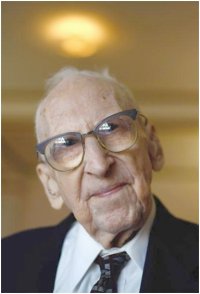 But Breuning is far from confined to bed. Why he gets all over town. Both the billings Gazette and the Great Falls Tribune report: Despite his age, Breuning is not confined to the Rainbow. A few years ago, he was given a motorized four-wheel scooter, and Moore might be able to get a photo of him zipping along the sidewalks downtown — if the weather's right. "Ten or 12 of us here have scooters, and we can go just about anywhere," Breuning said. (1,2) Breuning usually rises around 6:00 AM every morning, breakfasting at 7:00. He attends to errands and meets with friends until 2:00 PM when he usually retires to his room to read, write and listen to the radio. "Normally I eat about 600 calories for breakfast, eggs and toast, or French toast, or pancakes, or the fruit bar." By eating just two meals a day and restricting his calories to about 1,200, his weight has remained stable at 125 pounds for the past 30 years, said the 5-foot-6 Breuning.
Breuning has received a great deal of attention since attaining the status of oldest living man. Governor Brian Schweitzer recently paid him a visit and they talked politics and history for hours. Following Governor Schweitzer was Imperial Potentate Jack Jones making the trip from Tampa, Florida to honor this man. John Moore, a famous Pulitzer photographer from Denver, came to take his picture. KRTV of Great Falls also came and they tell us: Members of the organization (Masons) came from all over the state – and country – to honor the legend, including the Imperial Potentate of Shriners International and the highest ranking Shriner in the world, Jack Jones. Walter was given a plaque and pin for his seven-plus decades of dedication to the cause during a Sunday ceremony at the Rainbow Assisted Living Center in Great Falls. "There's many men who are interested in these organizations, but when it comes to commitment, Walter is the man," explained Grand Warden Tom Duffy, Jr. "He's had years of commitment, 75 plus in Masonry and Shrinedom. Boy, if Webster had a definition behind it, wouldn't it be Walter right behind 'commitment'?"
Middle picture shows De Smet, South Dakota where Breuning grew up.
A man who has seen and done much, that's Walter Breuning. But he has much more to do. He is still travelling upon that Level of time from whose bourne no traveller returns.
| |||||||
|
Page XI | |
|
Mountain peaks have always been around us, so it stands to reason that man has been climbing them
since the dawn of time. But that’s not the case. The Roman emperor Hadrian famously ascended Mount
Etna in 121 AD to watch the sun rise, but through the next 15 centuries, mountain climbing, particularly
in Europe, was discouraged, if not prohibited. The Matterhorn wasn’t scaled until 1865, more than 200
years after Darby Field had climbed Mount Washington in New Hampshire.
We’ve lost all that now, as science increasingly has backed superstition into a corner. No doubt that’s
why conspiracy theories are so popular today. We need a sense of the unknown, and something had to
take the place of the dragons.
Dan Brown’s book of Masonic intrigue titled “The Lost Symbol” is primed to be an off-the-charts best
seller and is the latest incarnation of this human paradox: We want desperately to know all the answers,
but understand that it’s more fun when we don’t. Were every conspiracy theory, from Roswell to the Trilateral
Commission, to be suddenly proved or disproved, we would need some other great unknown to
take their place. We want everything to be under our control. But we need elements that are not. It’s
what fuels the fires of curiosity, perhaps man’s most essential attribute. And while the enlightened
temptation is to sniff at every conspiracy theory that comes along, this is to dismiss their hidden value.
Take your average conspiracy theorist. He reads a lot. He researches a lot. He knows a lot. And he is insanely
curious. What’s wrong with any of that? Like anything, conspiracies can become obsessions, but
within reason they are just plain fun and, not infrequently, educational. You may find it hard to swallow
the idea of alien cover-ups and the theory that little green men came down from the skies and built the
pyramids, but then you ask yourself, who did? So you study the history, culture and religion of a marvelous
civilization.
I have a hunch most people knew there were no dragons before they “knew” there were no dragons.
Similarly, most people know Bill Clinton didn’t go around having his associates assassinated and George
Bush and Dick Cheney did not facilitate Sept 11 in order to achieve “United States global hegemony.”
But it’s the unknowns and what-ifs that make life interesting. In many ways, a question mark is more satisfying
than a period.
The danger, however, comes in taking the theories too seriously, in taking question marks and pretending they
are periods. By taking Brown’s previous book, “The DaVinci Code,” too seriously (or perhaps fearing others
would), the church launched its own conspiracy theory that the book was purposefully designed to stir anti-
Catholic sentiment.
I feel fairly safe in saying it was purposefully designed to make money.
The Masons, by contrast, seem more than willing to play along. (Too willing, a conspiracy theorist might say). They
know the interest in Masonry will skyrocket and they want word to get out. As one Mason said, “It’s not a problem
getting Masons to talk about Masonry; sometimes it’s a problem getting them to stop.”
Early dragon hunters were never able to bag a dragon. But climbing through the hills, they no doubt saw some beautiful
sights they wouldn’t have otherwise seen. Conspiracy theories are a good excuse to learn and read history. You
might not find any space aliens, but you will find out that the truth is fascinating enough on its own. | |
|
Page XII | |
|
From The Rural Masonic Lodge Newsletter
Officer Kimberly Barbour Munley was a member of North Carolina Wilmington Assembly 29, now Goldenrod Assembly 29, where she served as Worthy Advisor, and also as the North Carolina Rainbow Grand Musician. She was also a member of the Grand Cross of Color.
Kay Letterman, Supreme Inspector in North Carolina, said, "We are very proud of the courage that this young
lady displayed to save so many lives.” Kim is recovering from her injuries.
| |
Too many times, we are more concerned about performing the ritual perfectly without understanding what it means. I know many men that give great lectures, but will confide that they don’t even know what something means. Ritual for the sake of tradition is worthless. Ritual for the sake of enlightenment is valuable. An understanding of the ritual’s meaning is far more important than just memorizing it.
Fellowship without Frivolity
Whenever Masons decide to hold a function for fellowship, a discussion typically ensues about how to make the function have the smallest impact on the lodge’s coffers and the wallets of the members. This results in paper plates, meager meals, and boring events. To spend money wisely in order to make fellowship a grand time is wise for the lodge that wants to be successful.
Quantity without Quality
A lodge with seven great men that believe in the Masonic ideals and actively labor to improve themselves—and therefore the lodge—is far better off than a lodge with one hundred men that show up to lodge just to show up to lodge.
Education without Philosophy
Many times, we think of Masonic education as being a lesson on the local lodge’s history, a famous Mason, the history of the world wide fraternity, or how to do the ritual properly. But if no philosophy is covered in Masonic education, then little self improvement is accomplished. Discussing Masonic lessons in terms of philosophy, ideas, and a man’s conduct is what truly transforms men into Masons. It is important to discuss topics that are foreign to a lodge’s membership and it is sometimes even necessary to challenge our preconceived ideologies through Masonic education.
Charity without Connection
Big institutional charities often require that fund raisers be conducted and large checks written to the people that actually perform the charity. This type of charity is devoid of self improvement because it has no real connection. If we extend our hands to our needed Brethren and devote our own skills and time to their problems, then we are engaging in true, meaningful charity.
Frugality without Discretion
Frugality is not a tenet of Freemasonry, a cardinal virtue, or a Landmark. It is okay for the lodge to spend its funds on worthwhile activities that will enhance the Masonic experience of its Brethren. Not everything should be done in the cheapest way, a habit to which we have become accustomed.
Leadership without Competence
A man does not deserve to be Master of the lodge solely because he has spent a certain amount of years in the lodge. We elect leaders without any regard for the skills that they possess to function in that capacity. Only competent, qualified men should be elected to preside over the Craft.
Like what you are reading at the Euphrates? Email the author at euphratesblog@gmail.com to join the Banks of the Euphrates mailing list.
| |
|
Page XIII | ||||
|
By Brian R Ballou Boston Globe From The Rural Masonic Lodge Newsletter
Members of the Friends of Prince Hall Memorial Fund committee hope that will change. They plan to hold a dedication ceremony on Cambridge Common today in honor of Hall's birth and oversee the pouring of the foundation where the memorial is slated to stand. Although Hall's birthday remains unknown, some historians place it on 12 September 1735. "He was the first civil rights organizer in America,'' said Red T Mitchell Jr, a committee member who also is a Prince Hall Mason, as was his father. Not much is known about Hall's early life, but it is believed that he arrived in Boston from Africa in the mid-1700s at the age of 12 and that for 21 years he worked as an indentured servant for William Hall, who owned a tanning and leather dressing business, said Morgan James Peters, an associate professor of English and African-Ameri can Studies at the University of Massachusetts at Dartmouth, who in 2006 authored the article, "Prince Hall & The Roots of Black Nationalism.'' Peters is also the interim grand historian of the Prince Hall Grand Lodge of Massachusetts. William Hall emancipated Hall several months before the Boston Massacre of 1770, when British soldiers killed several civilians and help spark the American Revolution. Hall started his own leather business and worked as a barber and caterer. He was self-educated through books, especially those on philosophy, and through friendships with intellectuals, Peters said. Red T Mitchell Jr, a member of the Prince Hall Memorial Fund's committee, at the existing monument to Prince Hall in Copp's Hill Burying Ground (on the Masonic Walking Trail). After he was freed, Hall spoke against slavery and petitioned the Legislature to abolish the practice. Hall is believed to have met General George Washington on what is now Cambridge Common while Washington was organizing the Continental Army, and implored him to allow blacks to serve. Hall established African Lodge 1 in 1776, the first such Masonic lodge for blacks in America. He then received a charter from the Grand Lodge of England, which eventually led to the establishment of Prince Hall Grand Lodge. He died in his early 70s, and was buried in 1807 on Copp's Hill in the North End. There are about 47 Prince Hall Grand Lodges throughout the country and some 300,000 members. Mayor E Denise Simmons of Cambridge started the push for a monument for Hall in her city while she was a councilor in 2005 "I was putting together my own family history. My grandfather was a Prince Hall Mason, and I began to research the significance of the organization,'' she said. "As I got more interested in my grandfather as a mason, I began to wonder why nobody had ever installed a monument to Prince Hall, a man who had done such tremendous work.'' The Friends Committee is seeking to raise $100,000 for the cost of the memorial and has collected about $60,000 in private donations. Ted Clausen, the Cambridge artist who will create the memorial, said that he didn't know who Prince Hall was when he heard about the project but that after 45 minutes of research, "My first thought was, 'Why don't I know more about this man?' What we have here is a founding father of the civil rights movement and Free Black Masonry.'' Clausen said that in creating the memorial, he wanted to give others the same sense of discovery. Five granite stones will be cut in the fashion of 18th- and 19th-century tombstones. They will be 6 feet tall and 27 inches wide, designed in relation to the human body. The stones will form a circle, and quotes from civil rights leaders will be etched on the rough granite outside finish. Clausen called on juniors at Community Charter School of Cambridge to research quotes. "They worked hard and long and submitted to me a group of quotes, some of which we will use on the memorial,'' he said. "One of my definitions of public art is to get the public in it.''
Hall is considered a foundational voice for the likes of Martin Luther King Jr and Frederick Douglass. Clausen
typically uses text in his works, as with the Vendome Firefighters Memorial in Boston, a 31-foot-long granite
arc, and the Korean War Memorial in Somerville, a 53-foot diameter semicircle of quotes on granite and
bronze. Mitchell said the Hall memorial will be a lasting educational tool. "A lot of people think this
monument is just about Prince Hall, but it represents more, the start of emancipation, and the first blacks
to truly call themselves African-Americans,'' he said. "We're talking about those patriots of African descent
who helped lay the foundation of our nation during the Revolutionary period.".
| ||||
|
Page XIV | |
|
By Brian R Ballou For OpEdNews: Posted by Arthur Avalon
Masons have also been the victims of slander by misguided people who have claimed to be Christians in America. One of the first notable instances of that was against the very founders of the United States of America in the late 1700s, because most of the founding fathers were Deists, and many were Freemasons. They wanted to establish freedom of religion, and freedom from religious bigotry and theocratic imposition. But misguided, right-wing theocratic Christians didn't like that. In fact, they fought against it. That is why Thomas Jefferson wrote: "The clergy, by getting themselves established by law and ingrafted into the machine of government, have been a very formidable engine against the civil and religious rights of man." More to the point, Jefferson also wrote: "The returning good sense of our country threatens the clergy and they believe that any portion of power confided to me will be exerted in opposition to their schemes. And they believe rightly; for I have sworn upon the altar of God, eternal hostility against every form of tyranny over the mind of man. But this is all they have to fear from me, and enough too in their opinion, and this is the cause of their printing lying pamphlets against me. . ." Even more important, Jefferson also said: "Believing with you that religion is a matter which lies solely between man and his God, that he owes account to none other for his faith or his worship, that the legislative powers of government reach actions only, and not opinions, I contemplate with sovereign reverence that act of the whole American people which declared that their legislature should 'make no law respecting an establishment of religion, or prohibiting the free exercise thereof,' thus building a wall of separation between church and State." James Madison wrote: "What influence, in fact, have ecclesiastical establishments had on society? In some instances they have been seen to erect a spiritual tyranny on the ruins of the civil authority; on many instances they have been seen upholding the thrones of political tyranny; in no instance have they been the guardians of the liberties of the people. Rulers who wish to subvert the public liberty may have found an established clergy convenient auxiliaries. A just government, instituted to secure and perpetuate it, needs them not." And Madison also wrote: "Strongly guarded as is the separation between Religion and Government in the Constitution of the United States, the danger of encroachment by [Christian] Bodies, may be illustrated by precedents already furnished in their short history." Benjamin Franklin, Thomas Paine, John Adams and others, including Abraham Lincoln, felt the same way. (See the article-page on Little Known American History.) But, unfortunately, with respect to the need for religious pluralism and equality, the founding fathers' influence did not last for long. Aggressive, theocratic Christians gradually negated that pluralistic influence, and there have been times when they have become politically aggressive, as they are now and have been for the last 30 years. Another notable time was in the mid-1930s. In reaction to the success of the good liberal progressives, there was a revival of right-wing political activism driven by conservative, materialistic, dogmatic Christian sects. They sought to establish more firm "Christian" control in the United States, and they founded a so-called "Legion of Decency" designed to do that. It consisted of right-wing conservative Christian evangelicals and fundamentalists, conservative Catholics, and others --- pretty much the same denominations, sects and factions that even today make up the "Christian Right" and what they call a "Moral Majority" or "Christian Coalition." They think they are the true Christians, but they ironically act in opposition to true Christians, because true Christians actually care for and/or advocate for the majority, and especially the poor and the least of our brethren, just as Deists and Freemasons do. The latest rise of slander against Freemasonry began in the 1970s with the rise of the modern "Fundamentalist Evangelical Christian Right," because many of its leaders have made many misleading and even false claims about what Freemasonry is, and about what Masons are, and what they do. Since Freemasonry has been maligned by the American Christian Right, and especially since Dan Brown's newest book "The Lost Symbol" and the movie by the same name feature Freemasonry as an important part of the story, it has become even more important that some important facts about Freemasonry be told and the real truth revealed. Freemasonry is a fraternal society dedicated to universal brotherhood. It is non-sectarian, pluralistic, respectful of all religions, and based on brotherly love, self-examination, good will, charity, and mutual assistance for the common good. It has existed for many centuries. The roots of Freemasonry are ancient, but Freemasons were among the first significant organizations to foster what are called "esoteric" spiritual teachings in the 1700s in Europe, and then in America. They helped make Deism, Freemasonry and esoteric spiritual teachings accepted and popular. Mainstream Western philosophers of the 1700s followed that trend, and they also became fascinated with Eastern culture, religion, literature and philosophy, and that fascination began to reach its peak toward the end of the 1700s. In fact, it is what impelled the founding fathers to seek freedom from King George and his theocratic Church of England, and it is what caused them to be critical of the theocratic Christians in America. The name Mason refers to craftsmen, specifically to stonemasons all the way back to those who built the ancient Temple of Solomon. However, since Masons have been slandered and even persecuted throughout their history by certain power-hungry "religious" groups, Freemasonry has a tradition of secrecy. Even so, the secrecy tradition is not because Freemasonry is anything like a "cult." In fact, like Thomas Jefferson, Masons believe that one's spiritual and religious beliefs are a private matter and between each person and God, and are no one else's business. Moreover, Freemasonry has no single leader. It does not recruit members, nor does it coerce members in any way, and it does not claim to have knowledge of the only truth. Masons are free, and they can participate regularly, or sporadically, or rarely, as they choose. And they can also choose to end their membership if they wish, without any notice or complications. Freemasonry is not necessarily "religious." While the belief in a God or a Supreme Being is a requirement for Masons, no single religion dominates. In fact, Masonic rules ban even the discussion of religion and politics, because Masons understand that they could very well disagree about such matters, and that would cause disharmony among members. Freemasonry does not have any sort of global network, or even national network. There are many Masonic lodges, and they are not connected. In fact, there are some that very different than others in certain ways. And that's because Masons are free to follow their own sense of ethics, mutual respect, etc. And each lodge takes on the character of its members as a whole.
|
|
Page XV | |
Continued From Page XV
Contrary to what some uninformed critics claim, Masons are not members of "The Knights Templar." The Templars were an order of militant, medieval crusaders in the early 1300s, and modern Freemasonry did not become widespread or well known until three or four hundred years later. Furthermore, Masons are not part of a so-called "Illumanati." The original Illuminati died out about eight years after the American Revolution of 1776. And even though there have been so-called revivals of so-called "Illuminati" groups, they have been fraudulent organizations led by impersonators and pretenders who were and are not really enlightened. Now, as to the labeling of Freemasonry as "occultism," that is a complex issue, because the true meaning of the world "occult" means hidden. It is in some ways synonymous with the word "esoteric," which means "known only by a few." Neither term is negative, even though they have been grossly misunderstood and mislabeled by misguided, judgmental people. In fact, over the centuries they have succeeded in creating a pejorative connotation to the term "occult," and they have led people to believe that occult teachings have something to do with "satanism." Of course, that has been partly because there have been and are charlatans and pretenders who misuse the tools used in esoteric teachings to suit their own purposes, just as there are charlatans and pretenders who misuse the words in religious scriptures like the Bible to suit their own purposes. But, what can be bad is not the tools or the words, but those who misuse them out of spiritual ignorance. Some of the tools used in Freemasonry are the symbols used in the Judaic Kabbalah, known as The Secrets of the Torah (Old Testament), and also known as the Cabala and the Qaballah, and most of those symbols are also used in Astrology, Alchemy, and the Sacred Tarot. But all those systems of spiritual teaching are for self-examination and self-discovery. They are not religious, as we use the term, but they are actually designed to produce what true religion is supposed to produce, which is self-realization, unity, harmony, peace, freedom, love, and brotherhood. Most Masonic meetings in America are preceded by the pledge of allegiance to the flag, and support for the U.S. Constitution is a central component of American Masonic values. Eight signers of the American Declaration of Independence were Freemasons, including Benjamin Franklin and George Washington, and sixteen following presidents were also Freemasons. However, the only presidents who were Masons in the last 60 years were Gerald Ford and Harry Truman. Most Masons have learned to keep their Masonic membership to themselves. In alphabetical order by last name, here is a partial list of other famous American Freemasons, which includes: Irving Berlin, Composer; Hugo L. Black, US Associate Justice - John Blair, US Associate Justice - Ernest Borgnine, Actor - Omar N. Bradley, US Army General - Kit Carson, American Adventurer - Paul Foster Case, Founder of the Builders of the Adytum - Cecil B. DeMille, Movie Director - Everett Dirksen, U.S. Congressman and Senator - Bob Dole, US Senator - James Doolittle, US General and Shriner - William O. Douglas, US Associate Justice - Duke Ellington, Musician - Sam Ervin, US Senator - Henry Ford, founder of the Ford Motor Company - Charles Lindbergh, US Aviator - Thurgood Marshall, U.S. Supreme Court Associate Justice - Sam Nunn, US Senator - Arnold Palmer, Professional Golfer - Norman Vincent Peale, Inspirational Writer - Roy Rogers, American actor - Will Rogers, American political commentator and satirist - Franklin D. Roosevelt, U.S. President - Theodore Roosevelt, U.S. President - John Philip Sousa, Music Composer - Mark Twain, American author - Earl Warren, Chief Justice of the United States; There are many more Americans listed at the source where I got these names, which lists also many famous people from around the world who have also been and are Freemasons, including Winston Churchill, Prime Minister of England.
I list all those names, and direct you to the link that lists many others, to show you that Freemasons are diverse in their religions, politics, and ideologies. But those who become wise understand that brotherhood is far more important than those things. Quoted from Freemasonry, by Joseph J. Adamson.
| |
|
Page XVI | ||||||||
What if, instead, you watched mourners lift a wooden coffin to their shoulders, form a procession, and
solemnly march to the open grave? ….and what if all the Masons wore hats and brightly decorated aprons?
In late 2004, a handful of Texas Masons sought and received dispensation from the Grand Lodge of Texas
to hold 19th Century Masonic funeral services "for demonstration purposes" to educate the general public.
These Masons realized that the Masonic burial ceremony is one of the few opportunities non-Masons have
to see Masonry in action. Their belief was that this ceremony would generate questions from the public
and give them opportunities to speak to non-Masons about the benefits of Masonry. They began holding the
funeral ceremonies at Texas history events in early 2005. This effort has been very well received and has
offered wonderful opportunities to tell non-Masons about the good works that Masonry has provided and of
the tremendous impact Masonry has had on Texas.
|
|
Page XVII | |
This Month - The Masonic Trowel Website By Corky 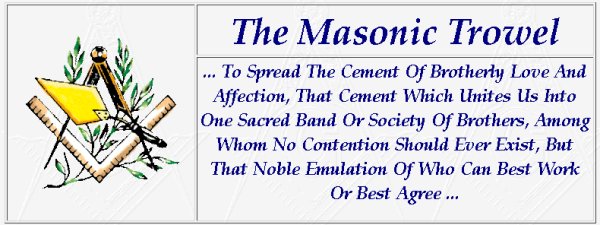 (Editor's Note - I borrow many of the stories from a number of sites with permission of the editor or authors and give proper credit when known. Although I try to pick out some of the better stories and articles for Masonic news, education and even a little fun, some viewers would like to read more. For that reason I am introducing some of the better Masonic education and news sites with this series. - Corky)
The main thing I remember was the free and easy appearance the site had back then. Most of the individual pages had a direct link front the front page instead of from a sub-category page. That gave the main page a kind of shingled roof appearance with little boxes for each link.
The remodeled site has a more sophisticated glossy look. I kind of miss the old more homey look, but it is much easier to search now.
The front page is now divided into five different major categories including , Masonic Talks, Masonic Books And Magazine, Useful Links and Clip Art.
Clicking on Educational Information for instance, takes you to the Masonic Articles by Subject page which has links to 7 other sub- category pages including, About Freemasonry, Symbolism, History about Freemasonry, Being a Mason and Master Mason, Historical Manuscripts, General Article, Degrees and About Other Masonic Bodies. Going deeper and clicking on About Freemasonry takes you to the page that gives you a choice of 18 different articles on the subject.
OK, you may say that this seems complicated, but how else could you find a particular page, with the article you wish to read, among the literally hundreds of pages on this site.
For a one stop shoping site for almost anything you want to know about Freemasonry, the Masonic Trowel is a good site to visit.
| |
|
Page XVIII | |
Online Security and Identity Theft By RWBro Barry Minster, PJGW From, Freemasons Victoria
| |
|
Page XIX | ||
From, Freemasons Victoria
The lodges in Japan, certainly the Yokosuka Lodge, meet every week of the year. One meeting per month is called a Stated Meeting and degree work is carried out. Other nights are devoted in a more casual way to organising charitable, social and community activities. Constituted in 1957, the Grand Lodge of Japan administers supreme Masonic authority within the political boundaries of Japan and there are now 18 Lodges. Prior to the formation of the Grand Lodge of Japan, however, Masonic Lodges had already been chartered under the authority of other Grand Lodges, and these Lodges were accorded the privilege of continuing to operate under their original jurisdictions. Consequently, Japan is also home to individual Masonic Lodges chartered under the Grand Lodges of England, Massachusetts USA, two from the Philippines and two from Scotland. Altogether more than 2,000 Masons are members of 24 Masonic Lodges in Japan. In the mid 1800s, some Japanese, especially samurai (professional warriors), assaulted foreigners to harass the weakening government. Such attacks became frequent and, following protests, the Japanese Government agreed to have the British and French troops stationed in Yokohama. It was during this period that the first Masonic lodge was introduced to Japan. A military lodge called Sphinx Lodge No.263, Irish Constitution, came to Japan with a detachment of the British 20th Regiment, arriving in Yokohama in 1864. While in Yokohama, the lodge held meetings and admitted civilian members. On leaving, brethren in Yokohama felt it desirable to form a local lodge and petitioned the UGL of England. Thus the first lodge, Yokohama Lodge No.1092 came into being, holding its first regular meeting on June 26, 1866. A total of six English and three Scottish lodges were formed in Japan before the last war. After the war, Masonic activities were resumed and the Grand Lodge of the Philippines began to found lodges in Japan. During a 10-year period from 1947 to 1956, 16 lodges were founded. Yokosuka Lodge was the first lodge established in Japan after World War II, receiving charter number 120 from the Grand Lodge of Free and Accepted Masons of the Philippines, April 1948. At the Stated Meeting of Yokosuka Lodge held on 7th June 1965, it was the unanimous vote of the members present to petition the Grand Lodge of Japan for a charter. This was granted at the Special Communications of the Grand Lodge of Japan on 25th June 1965. Thus Yokosuka Lodge of the Philippines No. 120 became Yokosuka Lodge No. 20. Next morning the Victorian brethren walked to the nearby Tokyo Tower and found the Grand Lodge building in its shadows. There they were greeted by the Grand Secretary, MWBro Phillip Ambrose, PGM, who had been alerted to the Victorians' presence by WBro Roy Rommelman of the Yokosuka Lodge the previous evening. They were then introduced to the Grand Master, MWBro Mike Setzer, with whom they spent considerable time in discussion.
RWBro Allan also took the tour to Hiroshima and then to Hong Kong, where the group
ventured to the headquarters of Freemasonry in Hong Kong, Zetland Hall, Kennedy Road,
to visit the Scottish constitution Lodge of St John. RWBro Allan writes in summary
of the journey, “Indeed the experiences of the trip highlighted the great privilege of
visiting Freemasons around the world.” |
|
Page XX | |

From The Rural Masonic Lodge Newsletter
Once again I am using the same excuse, I borrowed from a Masonic newsletter.
The Ledge (below) brings an exhilarating new experience to Chicago. At 1,353 feet up in the Willis Tower (formerly the Sears Tower)
The Ledge's glass boxes extend out 4.3 feet from the skyscraper's Skydeck on the 103rd floor.You'll get a great view, if you dare.
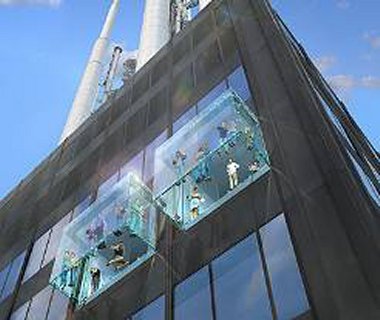
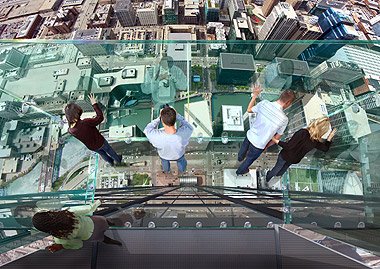
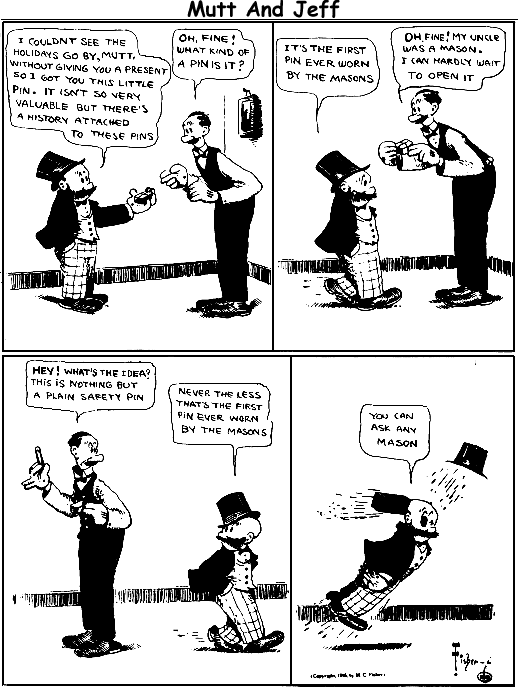
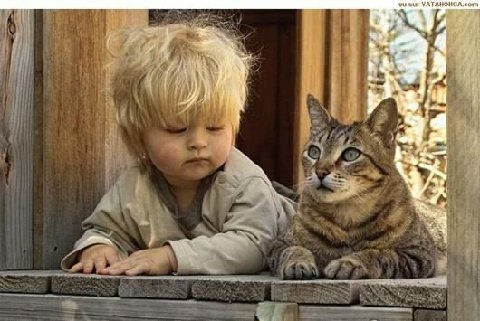 Johnny's Mother looked out the window and noticed Him "playing church" with their cat. He had the cat sitting quietly and he was preaching to it. She smiled and went about her work. A while later she heard loud meowing and hissing and ran back to the open window to see Johnny baptizing the cat in a tub of water. She called out, " Johnny, stop that! The cat is afraid of water!" Johnny looked up at her and said, "He should have thought about that before he joined my church."

. |
|
|

